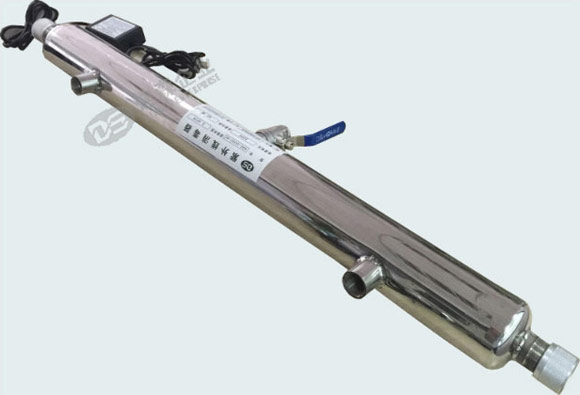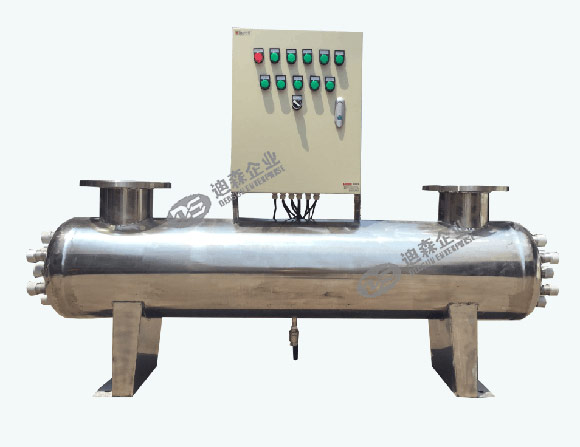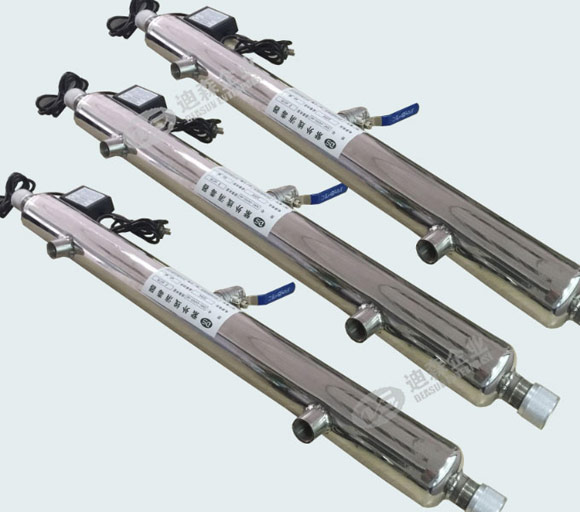



Principles of UV disinfection
Ultraviolet rays can be divided into the UVA (320-400nm, UV-C (200-275nm) and the real part of the ultraviolet. UV treatment is actually the use of UV-C part, in the band 260nm has recently been shown to be the most efficient UV disinfection.
Disson UV disinfection optics, microbiology, mechanical, chemical, electronics, fluid mechanics and other integrated science as a whole. Ultraviolet UV-C produced by specially designed high-efficiency, high-intensity and long-life ultraviolet UV-C light generator. When the water bacteria, viruses, etc. by a certain dose of ultraviolet UV-C light (wavelength 253.7nm) after irradiation. Its cell DNA and structural damage, cell regeneration can not be carried out, so as to achieve water disinfection and purification. The wavelength of 185nm spectral lines can also break down organic molecules in water, resulting in hydrogen radicals and organic molecules in water oxidation of carbon dioxide to achieve the purpose of removing TOC.
UV disinfection advantages
Efficient sterilization: UV on bacteria, viruses, sterilization generally used in one to two seconds to reach 99% -99.9% of the sterilization rate.
Efficient broad-spectrum sterilization: broad-spectrum ultraviolet disinfection is the highest, it is almost all of the bacteria, viruses can efficiently kill.
No secondary pollution: UV sterilization does not add any chemicals, so it will not produce secondary pollution of water bodies and the surrounding environment. Does not change any component in water.
Operational safety and reliability: traditional sales techniques such as the use of chloride or ozone, the consumer itself is highly toxic, flammable substances. The UV disinfection system does not exist such a security risk.
Cost and low operation and maintenance costs: a small area of ultraviolet disinfection equipment, structures require a simple, so a small total investment. In terms of operating costs are relatively low, in the 1000 tons of water treatment capacity level, its cost is chlorine disinfection of 1/2.
Features of UV disinfection equipment
Selection of high efficiency UV-C (LL or LH) UV lamp: selection of the world's leading low-pressure high-intensity UV lamp, lamp life guarantee 8000-12000 hours.
Selection of high transmittance, high purity quartz tube, to ensure that more than 90% of ultraviolet rays through.
Selection of the world's advanced constant, high-intensity UV-specific ballast, to ensure that the entire system in the complex case of normal operation.
Use high-quality stainless steel for the reactor (304 or 316), the reactor wall for special polishing to improve the sterilization effect.
Applications
Food, beverages, beer, cooking oil, all kinds of canned food, cold drinks and other water disinfection
Electronic industry ultrapure water, military camp, field water supply system
Hospitals, laboratory water, high levels of pathogenic body water disinfection
Residential buildings, residential, office, hotels, restaurants, water and other application of water disinfection
Aquatic processing and purification, shellfish purification, purification and disinfection of fish processing
Urban sewage disinfection
Swimming pool, water and other recreational water disinfection
Thermal power, industrial production of cooling water, central air conditioning system cooling water disinfection
Biological, chemical and pharmaceutical, aquaculture water, the total treated water up to 20 million tons per day or more
Agricultural water, greenhouse water, irrigation and disinfection
Inactivation of microbes by UV disinfection





